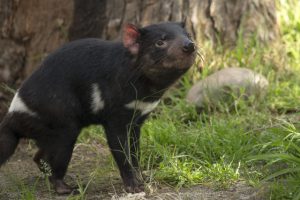 The San Diego Zoo’s Tasmanian devils, McLovin and Quirindi, at their home inside the Conrad Prebys Australian Outback. Photo courtesy San Diego Zoo.
The San Diego Zoo’s Tasmanian devils, McLovin and Quirindi, at their home inside the Conrad Prebys Australian Outback. Photo courtesy San Diego Zoo.
New research shows insurance populations – those isolated from threats to prevent extinctions – could help preserve many animals.
The study was authored and partially funded by the San Diego Zoo Wildlife Alliance and Toledo Zoo, both of which have such captive populations, in this case of the endangered Tasmanian devil.
The work, one of the largest wildlife genetic studies in the world, has found that insurance populations of the carnivorous marsupial, in zoos and on Maria Island off the east coast of Tasmania, are as genetically diverse as wild populations.
This means insurance animals are as healthy and likely to reproduce and can be reintroduced into the wild, bolstering the species’ numbers.
The research, published in iScience, is being led by the University of Sydney’s Wildlife Genomics Group, in collaboration with the Tasmanian government.
Population of the Tasmanian devil – which are only found in their namesake state – have declined by an estimated 80% since 1996 due to a contagious cancer, devil facial tumour disease (DFTD). They are also threatened by roadkill, habitat destruction and climate change.
The fact that the insurance population animals are as genetically robust as the wild ones shows specific breeding strategies are effective, study co-author Dr Carolyn Hogg said.
“The consistency is likely thanks to our ongoing strategic management of the insurance population, which includes over 37 zoos, as well as devils on Maria Island,” she explained. “By integrating orphan joeys that have been exposed to DFTD in the wild, we have ensured we have captured any genetic changes as a result of the disease.
James Biggs, director of conservation and population management for the Zoo and Aquarium Association, who manages the protected Tasmanian devil population, said: “This program demonstrates the role and value of zoos in buying time for a species until the primary threats are addressed, and wild populations can be restored.”
Hogg added that the breeding strategy can be applied to other endangered species and is therefore a useful tool to address the global biodiversity crisis.
“We have already applied it to species which are part of different safe haven (fenced site) populations on the Australian mainland, such as bilbies and woylies – an extremely rare, small marsupial,” she said.
Around 1 million species already face extinction worldwide, many within decades, according to the recent Intergovernmental Science-Policy Platform on Biodiversity and Ecosystem Services (IPBES) assessment report.
Between 2012-2021, the researchers examined over 1,300 wild and insurance population Tasmanian devils. They were collected from 31 sites across the species’ range – covering more than 40,000 square miles.
The researchers analyzed both genome-wide diversity and the diversity of over 500 critically important genes associated with immunity and reproduction and found no substantial differences between wild and insurance animals.
The researchers commenced trial releases of insurance population devils in 2015. With the new study’s results, they will continue to monitor animals’ health and genetics for at least four to six years – equivalent to two to three generations of devils.
The world’s largest carnivorous marsupial, the Tasmanian devil was once prevalent throughout Australia, but is thought to have become extinct on the mainland around 400 years ago due to predation by wild dogs.
The devils’ name, courtesy of early European settlers, stems from their feisty natures – the settlers had observed them angrily fighting for mates and defending themselves against predators.
